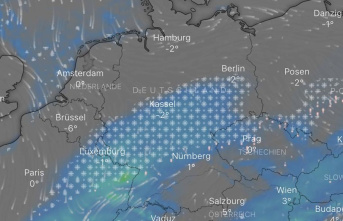With a water level of zero centimetres, the Rhine only reached a historic low in August 2022. Could that happen again this year? According to climatologists and meteorologists, this is difficult to predict. But one thing is certain: scarcity of water is a trend – even in winter. At the beginning of March, the Rhine level dropped to 1.75 meters. An even lower water level was last measured in 1971.
Things are hardly looking any better around Germany. Water is scarce in Italy, and the government is planning a campaign to sensitize citizens to save water. The situation in France is also dramatic: it has not rained there for 30 days in a row. In addition, the country is still exhausted from last year's drought. The soil is correspondingly dry, the country's water reserves are threatened, and measures have already been taken in some regions. Irrigating gardens or sports stadiums and washing cars is taboo in some regions - and that's in winter, when there is actually a lot of rain.
Winter drought is a term that has often haunted the news world in this context. Andreas Marx, head of the German Drought Monitor at the Helmholtz Center for Environmental Research, considers it a buzzword. Because that would mean that the drought lasts only in the winter months from December to February. "And that shows our German lack of understanding for long-lasting drought events," says Marx to the star.
It is undisputed that the last few months have been too warm and too dry. The German Weather Service (DWD) speaks of the twelfth warm winter in a row, with an average temperature increase of almost three degrees compared to the years 1961 to 1990. The DWD also speaks of a lack of snow.
Are drought and low water levels the new normal in Germany and Europe? "No," says Marx. "We have known for 15 years from climate simulations that Germany will not dry up as a result of climate change." Although the temperature in the Federal Republic will rise, Germany "will still be a water-rich country at the end of the century".
According to Marx, the current drought is not an extreme event like heat, storms, floods - events that last from a few hours to a few days to weeks. "Droughts can last for years," explains Marx. In some regions of Germany it has been permanently too dry since 2018, according to maps from the German Drought Monitor. There is now almost no part of the Federal Republic that is not affected. But depending on the region, the drought varies in severity.
And it also makes a difference how deep the drought goes. In winter, because of the otherwise frequent rainfall, it is normal for "the soil to be soaking wet down to a depth of half a meter," says Marx. That's not the problem this year either. The Bavarian State Office for the Environment, among others, has warned of droughts and endangered crop yields this year. Marx, however, considers this to be speculation.
Scientifically, drought predictions are practically impossible. April in 2014 and 2021 was also dry, with farmers warning of a difficult year for the harvest. "But then it rained normally in the following months, there were no pronounced heat waves and agriculture brought above-average yields."
That could happen again this year. "If it rains normally and the soil gets normally wet, the agricultural plants can grow very well," says Marx.
The summer, on the other hand, could become a stress test for the trees. Overall, the past five years have been too dry, which is also evident in the deeper regions of the earth below half a meter - where trees are anchored with their roots. This permanent dryness in the overall soil has contributed to the fact that 500,000 trees have recently been lost. According to Marx, whether the situation will improve depends on the temperature and precipitation in the coming months.
Both are difficult to predict. However, meteorologists assume that temperature records could be broken again in 2023. The reason for this is not only climate change, but also the recurring weather phenomenon El Niño off the west coast of Latin America. It pops up every few years and can push up global temperatures further.
El Niño and its counterpart La Niña favor extreme weather in different regions of the world. El Niño describes the warming of surface water in the eastern Pacific and changes in air and water currents worldwide. It usually brings severe drought in Australia, parts of Africa and South America and heavy rainfall along the American Pacific coast to California. La Niña is thought to be a cold phase, when currents carry solar heating to deep waters of the western Pacific, where it is stored.
Over the past three years, global warming has been mitigated by La Niña. Now the signs of an El Niño are increasing. According to the World Weather Organization (WMO), the probability for this year was 55 percent. 2016 was the year with the highest average temperature since industrialization. It was about 1.3 degrees above the pre-industrial level (1850-1900). According to the WMO, it was marked by an El Niño. It could be that time again this year. The probability of a hot and dry 2023 is at least there - and could exacerbate global warming.
Marx remains optimistic, however. Climate change is bringing changes to which we have to adapt. "Nevertheless, in the future we must be better prepared for both drier summers and periods of drought lasting several years." July to September remain critical months - but precise forecasts are at least speculative.
Sources: Helmholtz Institute drought monitor, "Kölner Stadt-Anzeiger", "The Guardian", "Bayerisches Wochenblatt", with material from DPA and AFP











